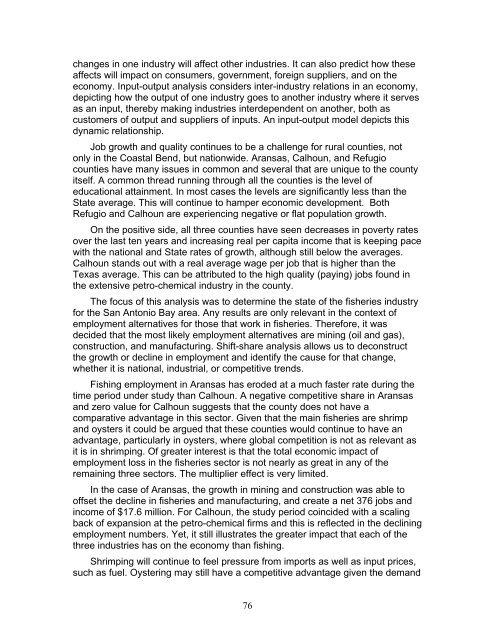The Economic Value of Water and Ecosystem Preservation
The Economic Value of Water and Ecosystem Preservation
The Economic Value of Water and Ecosystem Preservation
Create successful ePaper yourself
Turn your PDF publications into a flip-book with our unique Google optimized e-Paper software.
changes in one industry will affect other industries. It can also predict how these<br />
affects will impact on consumers, government, foreign suppliers, <strong>and</strong> on the<br />
economy. Input-output analysis considers inter-industry relations in an economy,<br />
depicting how the output <strong>of</strong> one industry goes to another industry where it serves<br />
as an input, thereby making industries interdependent on another, both as<br />
customers <strong>of</strong> output <strong>and</strong> suppliers <strong>of</strong> inputs. An input-output model depicts this<br />
dynamic relationship.<br />
Job growth <strong>and</strong> quality continues to be a challenge for rural counties, not<br />
only in the Coastal Bend, but nationwide. Aransas, Calhoun, <strong>and</strong> Refugio<br />
counties have many issues in common <strong>and</strong> several that are unique to the county<br />
itself. A common thread running through all the counties is the level <strong>of</strong><br />
educational attainment. In most cases the levels are significantly less than the<br />
State average. This will continue to hamper economic development. Both<br />
Refugio <strong>and</strong> Calhoun are experiencing negative or flat population growth.<br />
On the positive side, all three counties have seen decreases in poverty rates<br />
over the last ten years <strong>and</strong> increasing real per capita income that is keeping pace<br />
with the national <strong>and</strong> State rates <strong>of</strong> growth, although still below the averages.<br />
Calhoun st<strong>and</strong>s out with a real average wage per job that is higher than the<br />
Texas average. This can be attributed to the high quality (paying) jobs found in<br />
the extensive petro-chemical industry in the county.<br />
<strong>The</strong> focus <strong>of</strong> this analysis was to determine the state <strong>of</strong> the fisheries industry<br />
for the San Antonio Bay area. Any results are only relevant in the context <strong>of</strong><br />
employment alternatives for those that work in fisheries. <strong>The</strong>refore, it was<br />
decided that the most likely employment alternatives are mining (oil <strong>and</strong> gas),<br />
construction, <strong>and</strong> manufacturing. Shift-share analysis allows us to deconstruct<br />
the growth or decline in employment <strong>and</strong> identify the cause for that change,<br />
whether it is national, industrial, or competitive trends.<br />
Fishing employment in Aransas has eroded at a much faster rate during the<br />
time period under study than Calhoun. A negative competitive share in Aransas<br />
<strong>and</strong> zero value for Calhoun suggests that the county does not have a<br />
comparative advantage in this sector. Given that the main fisheries are shrimp<br />
<strong>and</strong> oysters it could be argued that these counties would continue to have an<br />
advantage, particularly in oysters, where global competition is not as relevant as<br />
it is in shrimping. Of greater interest is that the total economic impact <strong>of</strong><br />
employment loss in the fisheries sector is not nearly as great in any <strong>of</strong> the<br />
remaining three sectors. <strong>The</strong> multiplier effect is very limited.<br />
In the case <strong>of</strong> Aransas, the growth in mining <strong>and</strong> construction was able to<br />
<strong>of</strong>fset the decline in fisheries <strong>and</strong> manufacturing, <strong>and</strong> create a net 376 jobs <strong>and</strong><br />
income <strong>of</strong> $17.6 million. For Calhoun, the study period coincided with a scaling<br />
back <strong>of</strong> expansion at the petro-chemical firms <strong>and</strong> this is reflected in the declining<br />
employment numbers. Yet, it still illustrates the greater impact that each <strong>of</strong> the<br />
three industries has on the economy than fishing.<br />
Shrimping will continue to feel pressure from imports as well as input prices,<br />
such as fuel. Oystering may still have a competitive advantage given the dem<strong>and</strong><br />
76
















